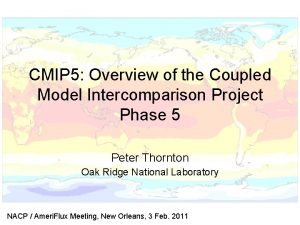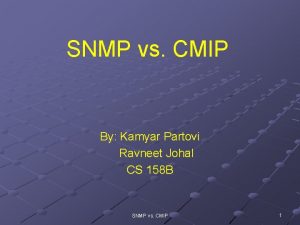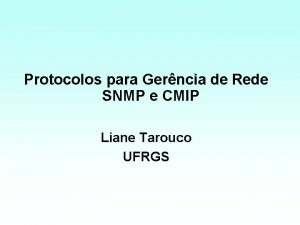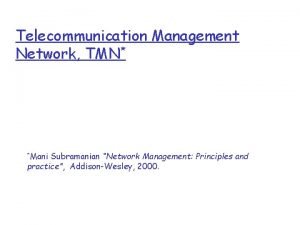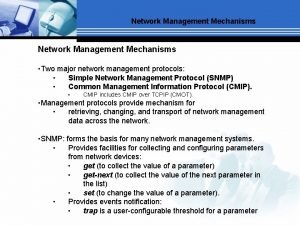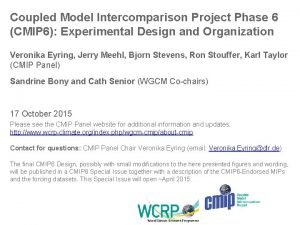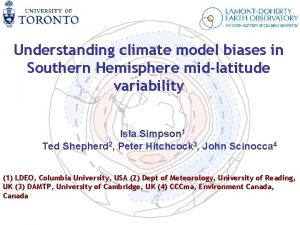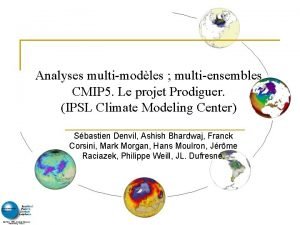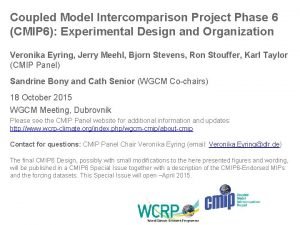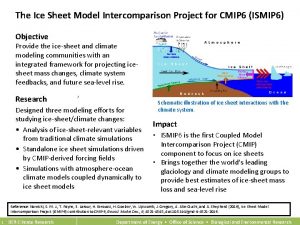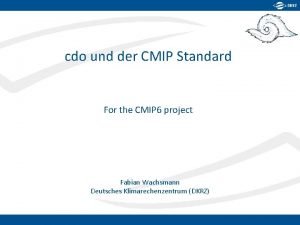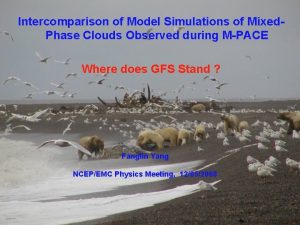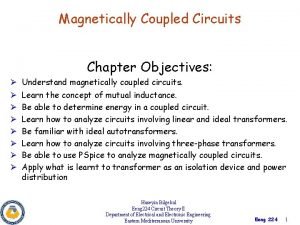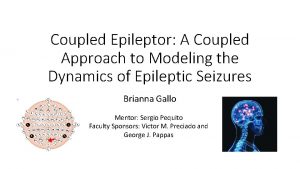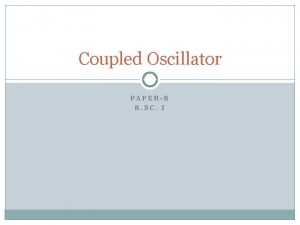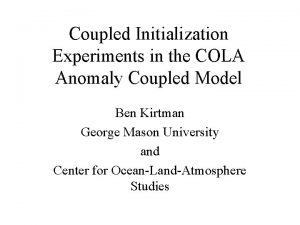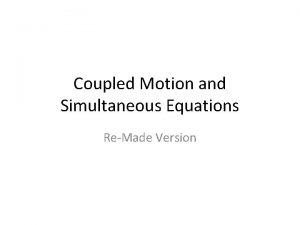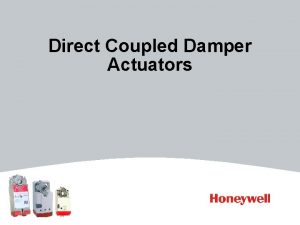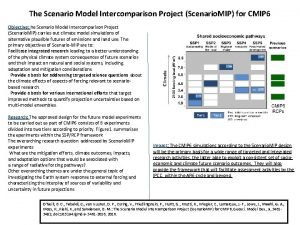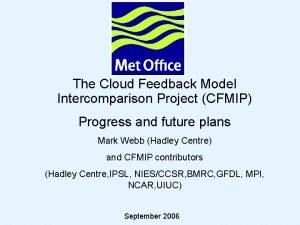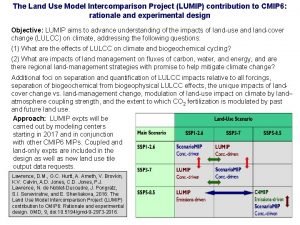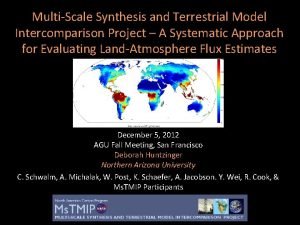Coupled Model Intercomparison Project Phase 6 CMIP 6



















- Slides: 19

Coupled Model Intercomparison Project Phase 6 (CMIP 6): Experimental Design and Organization Veronika Eyring, Jerry Meehl, Bjorn Stevens, Ron Stouffer, Karl Taylor (CMIP Panel) Sandrine Bony and Cath Senior (WGCM Co-chairs) 17 October 2015 Please see the CMIP Panel website for additional information and updates: http: //www. wcrp-climate. org/index. php/wgcm-cmip/about-cmip Contact for questions: CMIP Panel Chair Veronika Eyring (email: Veronika. Eyring@dlr. de) The final CMIP 6 Design, possibly with small modifications to the here presented figures and wording, will be published in a CMIP 6 Special Issue together with a description of the CMIP 6 -Endorsed MIPs and the forcing datasets. This Special Issue will open ~April 2015.

CMIP 6 Organization • CMIP Panel (V. Eyring (chair), J. Meehl, B. Stevens, R. Stouffer, K. Taylor) which is responsible for direct coordination of CMIP and overseeing the whole CMIP process. • Sub-committee of WCRP’s Working Group of Coupled Modelling (WGCM, co-chairs S. Bony and C. Senior). • WGCM Infrastructure Panel (WIP, co-chairs V. Balaji & K. Taylor): Establishes standards and policies for sharing climate model output; puts the data request together technically (M. Juckes). CMIP 6 Design • Based on the summer 2013 CMIP 5 survey and Aspen & WGCM/AIMES 2013 meetings • Initial proposal for the design of CMIP 6 (Meehl et al. , EOS, 2014). • Feedback on this initial CMIP 6 proposal has being solicited over the year from modeling groups and model analysts until September 2014. • The WGCM and the CMIP Panel have then finalized the CMIP 6 design at the WGCM 18 th session (October 2014, Grainau) in consultation with the model groups and MIP co-chairs.

CMIP 6 Design: Scientific Focus • • The scientific backdrop for CMIP 6 is the WCRP Grand Challenges: 1. Clouds, Circulation and Climate Sensitivity 2. Changes in Cryosphere 3. Climate Extremes 4. Regional Sea-level Rise 5. Water Availability 6. Decadal Predictability (pending) 7. Biogeochemical forcings and feedbacks (pending) The specific experimental design is focused on three broad scientific questions: 1. How does the Earth System respond to forcing? 2. What are the origins and consequences of systematic model biases? 3. How can we assess future climate changes given climate variability, predictability and uncertainties in scenarios?

CMIP 6 -Endorsed Model Intercomparison Projects (MIPs) Ongoing Diagnosis, Evaluation, and Characterization of Klima (DECK) Experiments DECK (entry card for CMIP) i. AMIP simulation (~19792014) ii. Pre-industrial control simulation iii. 1%/yr CO 2 increase iv. Abrupt 4 x. CO 2 run CMIP 6 Historical Simulation (entry card for CMIP 6) v. Historical simulation using CMIP 6 forcings (1850 -2014) Note: The themes in the outer circle of the figure might be slightly revised at the end of the MIP endorsement process (DECK & CMIP 6 Historical Simulation to be run for each model configuration used in the subsequent CMIP 6 -Endorsed MIPs)

CMIP Continuity

Specifics DECK & Historical Experiment Historical AMIP Pre-industrial control 1 %/yr CO 2 CMIP 6 label Experiment Description Forcing methods Observed SSTs and SICs prescribed Coupled atmosphere/ocean prepi. Control industrial control run (concentration driven) CO 2 prescribed to increase at 1%/yr until concentrations have quadrupled, and then 1 pct. CO 2 (optionally) extended 160 years with CO 2 concentration held constant CO 2 concentration -driven amip Quadruple CO 2 abruptly abrupt 4 x. C abruptly, then quadrupled and then O 2 hold fixed held constant Past ~1. 5 centuries CO 2 emission- or concentrationdriven CO 2 concentration -driven CO 2 emission- or Simulation of the recent concentrationhistorical past driven Start Year End Year 1979 2014 1850 n/a n/a Minimum # Major purpose Years Per Simulation 36 Evaluation 500 Evaluation, unforced variability 140 Climate sensitivity, feedbacks n/a 150 Climate sensitivity, feedbacks, fast responses 1850 2014 165 Evaluation

Specifics DECK & Historical Minimum Total # Years DECK Total DECK Historical Abrupt 4 x. CO 2 1 %/yr CO 2 Pre-industrial control AMIP 0 100 200 300 400 500 600 700 800 900

Specifics DECK & Historical Exp. Volcanic Stratospheric Aerosol Solar Variability Other forcins Historical AMIP Preindustrial control OBS OBS transient Annual mean background concentrations (or optical depths) at the time-mean level of the Historical (1851 -2014). This means that Historical and pi. Control have the same longterm climate forcing. O 1: mean of solar over the historical period O 2: value at end of the historical run (which would then be carried on into the future); O 3: 1850 solar value as constant --- Given that the Historical starts in 1850, the pi. Control should have 1850 atmospheric composition, not true pre-industrial As in picontrol --- As in picontrol OBS transient 1 %/yr CO 2 --Quadruple --CO 2 abruptly, then hold fixed Past ~1. 5 OBS centuries

CMIP 6 -Endorsed MIPs Main Criteria for Endorsement 1. The MIP and its experiments address at least one of the key science questions of CMIP 6. 2. The MIP demonstrates connectivity to the DECK experiments and the CMIP 6 Historical Simulation. 3. The MIP adopts the CMIP modeling infrastructure standards and conventions. 4. All experiments are tiered, well-defined, and useful in a multi-model context and don’t overlap with other CMIP 6 experiments. 5. Unless a Tier 1 experiment differs only slightly from another well-established experiment, it must already have been performed by more than one modeling group. 6. A sufficient number of modelling centers (~8) are committed to performing all of the MIP‘s Tier 1 experiments and providing all the requested diagnostics needed to answer at least one of its science questions. 7. The MIP presents an analysis plan describing how it will use all proposed experiments, any relevant observations, and specially requested model output to evaluate the models and address its science questions. 8. The MIP has completed the MIP template questionnaire. 9. The MIP contributes a paper on its experimental design to the CMIP 6 Special Issue. 10. The MIP considers reporting on the results by co-authoring a paper with the modelling groups. * For “Diagnostic-MIPs“ only non-experimental criteria apply

CMIP 6 -Endorsed MIPs and Model Groups’ Commitments to Participate in each MIP 0 5 10 15 25 13 Aer. Chem. MIP C 4 MIP Long Name of MIP (Short Name of MIP) Aerosols and Chemistry Model Intercomparison Project CFMIP 1 (Aer. Chem. MIP) DAMIP Coupled Climate Carbon Cycle Model Intercomparison Project DCPP 2 4 (C MIP) FAFMIP 3 Cloud Feedback Model Intercomparison Project (CFMIP) Geo. MIP Detection and Attribution Model Intercomparison Project 4 GMMIP (DAMIP) High. Res. MIP 5 Decadal Climate Prediction Project (DCPP) ISMIP 6 6 Flux-Anomaly-Forced Model Intercomparison Project (FAFMIP) LS 3 MIP 7 Geoengineering Model Intercomparison Project (Geo. MIP) LUMIP 8 Global Monsoons Model Intercomparison Project (GMMIP) 9 High Resolution Model Intercomparison Project (High. Res. MIP) OMIP 10 Ice Sheet Model Intercomparison Project for CMIP 6 (ISMIP 6) PMIP 11 Land Surface, Snow and Soil Moisture MIP (LS 3 MIP) RFMIP 12 Land-Use Model Intercomparison Project (LUMIP) Scenario. MIP 13 Ocean Model Intercomparison Project (OMIP) Vol. MIP 14 Paleoclimate Modelling Intercomparison Project (PMIP) CORDEX 15 Radiative Forcing Model Intercomparison Project (RFMIP) Dyn. Var 16 Scenario Model Intercomparison Project (Scenario. MIP) SIMIP 17 Volcanic Forcings Model Intercomparison Project (Vol. MIP) VIACS AB Coordinated Regional Climate Downscaling Experiment 18 (CORDEX) 20 19 19 14 17 10 10 20 15 11 13 13 21 14 11 23 11 13 13 17 14

MIPs Priorities for CMIP 6 Science Questions 2 Forcings and Feedbacks 3 Systematic Biases Future Climate Change 16 18 16 14 12 10 8 6 4 2 0 1 2 3 0

MIPs Priorities for WCRP Grand Challenges Clouds, Circulation and Climate Sensitivity 4 7 2 Changes in Cryosphere Climate Extremes Water Availability Regional Sea-level Rise 1 2 2 3 Decadal Predictions Biogeochemical forcings and feedbacks 9 8 7 6 5 4 3 2 1 0 1 2 3 4 5 6 7 0

Minimum Total # Years DECK Total DECK Historical Abrupt 4 x. CO 2 1 %/yr CO 2 Pre-industrial. . . AMIP 0 200 400 600 800 1000

Routine Benchmarking and Evaluation Central Part of CMIP 6 CMIP evaluation tool to produce well-established analyses as soon as model output becomes available e. g. , Community-developed ESM Evaluation Tool http: //www. pa. op. dlr. de/ESMVal. Tool (Eyring et al. , GMDD, 2015) and PCMDI metrics package - Link to WGNE/WGCM Climate Model Metrics Panel Similar to Figure 9. 7 of AR 5 Monsoon Precipitation Intensity and Domain CMIP 5 MMM Running alongside the ESGF AR 5 Chapter 9 CMIP 5 MMM - OBS Similar to Figure 9. 7 of AR 5 Link to projections Similar to Figure 9. 5 of AR 5 Similar to Figure 9. 24 of AR 5

Under-Exploited Observations for Model Evaluation Observations for Model Intercomparison Projects (obs 4 MIPs) WDAC Task Team on Observations for Model Evaluation CMIP 6 How to bring as much observational scrutiny as possible to the CMIP/IPCC process? How to best utilize the wealth of satellite observations for the CMIP/IPCC process? • Obs 4 MIPs has defined a set of technical specifications and criteria for developing observational data sets that are technically aligned with CMIP model output (with common file format, data and metadata structure). • Over 50 datasets that conform to these standards are now archived on the ESGF alongside CMIP model output (Teixeira et al. , 2014), including ESA CCI data • Data users have enthusiastically received Obs 4 MIPs

Finalize scenario choice, March 2015 (O’Neill, Tebaldi, van Vuuren) WGCM Jan 1 April July CMIP 6 1 st draft Review Design 2015 description 2015 forcings 2015 of forcings CMIP 6 Design Special Issue including forcing description Oct 2015 descriptions Jan 1 2016 PI/Historical SLCF emissions (S. Smith) Historical GHG emissions to 2014 (B. Andres) CMIP 6 Timeline April 2016 July 2016 Oct 2016 Jan 1 2017 Historical SLCF emissions with uncertainties, seasonality, + (S. Smith) = prototype ready Gridded GDP and population maps etc. (HYDE & IIASA website) Historical land use (G. Hurtt, D. Lawrence) = Pre-industrial ready Historical GHG concentrations (M. Meinshausen) Historical ozone concentrations (M. Hegglin, J. -F. Lamarque) Historical aerosol concentrations (B. Stevens) Solar past and future (K. Matthes, B. Funke) Volcanoes (L. Thomason et al. ) Future emissions (IAMs) Gridding & Harmonization past to future (IAMs) Future GHG concentrations (IAMs) Future ozone and aerosol concentrations (M. Hegglin, J. -F Lamarque, B. Stevens) Future harmonized land use dataset (G. Hurtt, D. Lawrence) PI control and idealized model experiments: DECK CMIP 6 Historical Simulation Scenario. MIP global model runs Nominal Period of CMIP 6 (2015 -2020)

CMIP 6 Status - Status and Outlook CMIP 6 Organization and Design finalized CMIP 6 MIP endorsement of April 2015 proposals finalized Timelines in place forcing datasets CMIP 6 Simulation Period (2016 -2020) Infrastructure in preparation (including data request) by WGCM Infrastructure Panel (WIP) CMIP 6 Participating Model Groups: > 30 using a hierarchy of models CMIP 6 Scenarios - New scenarios span the same range as the RCPs, but fill critical gaps for intermediate forcing levels and questions for example on short-lived species and land-use. A central goal of CMIP 6 is routine evaluation of the models with observations - Coordinated by the WGNE / WGCM climate diagnostics and metrics panel in collaboration with the CMIP Panel Workshops/meetings - 18 -20 October 2015: WGCM-19 (Dubrovnik, Croatia) 20 -23 October 2015: WCRP/FP 7 EMBRACE Workshop on CMIP 5 Model Analysis and Scientific Plans for CMIP 6 (Dubrovnik, Croatia) Geosci. Model Dev. Special Issue on CMIP 6 (July 2015 - December 2016) - Overview of the CMIP 6 Design and Organization (Eyring et al. , in prep, GMD, 2015) Experimental design from all CMIP 6 -Endorsed MIPs (submission by 31 March 2016) Description of the CMIP 6 forcing data Description of evaluation procedures (including obs 4 MIPs) and Infrastructure http: //www. wcrp-climate. org/index. php/wgcm-cmip/about-cmip

CMIP 6 Special Issue in GMD 1 2 3 4 5 6 7 8 9 10 11 12 13 14 15 16 17 18 19 20 21 22 23 24 25 26 27 28 29 30 31 32 33 34 35 CMIP 6 Experimental Design & Organisation Aer. Chem. MIP C 4 MIP CFMIP DAMIP DCPP FAFMIP Geo. MIP GMMIP High. Res. MIP ISMIP 6 LS 3 MIP LUMIP OMIP PMIP RFMIP Scenario. MIP Vol. MIP CORDEX* Dyn. Var* SIMIP* VIACS AB* Historical SLCF and GHG Emissions Global Gridded Land-use Forcing Datasets Historical GHG concentrations Ozone and Stratospheric Water Vapor Concentrations Aerosol Concentrations Solar forcing Stratospheric Aerosol Data Set Future Emissions AMIP SSTs and Sea Ice Datasets WGCM Infrastructure Panel (WIP) CMIP 6 Data Request WGNE/WGCM climate model diagnostics and metrics panel WDAC Task Team on Observations for Model Evaluation Overview CMIP 6 -Endorsed MIP CMIP 6 -Endorsed MIP CMIP 6 -Endorsed MIP CMIP 6 -Endorsed MIP CMIP 6 -Endorsed MIP CMIP 6 -Endorsed MIP Forcings DECK and Historical Simulation Forcings DECK and Historical Simulation Should be described in Scenario. MIP paper? Forcings DECK and Historical Simulation Infrastructure Model Evaluation

Near-term Issues 1. DECK – Entry card – Specifics on the DECK forcings and setup • SIZE: – The number of the CIP 6 -Endorsed MIPs and the associated large number of • • Forcings CMIP 6 Special Issue in GMD on the experimental design and orgnisation: Timeline – Overview paper (asap) – MIP papers by end of March 2016 – Deadline for submission of Forcing paper? Invitations (see previous table) Review • Data Request – The standard list for the DECK – timeline
 Coupled model intercomparison project phase 5
Coupled model intercomparison project phase 5 Cmip vs snmp
Cmip vs snmp Protocolo cmip
Protocolo cmip Cmip network management
Cmip network management Cmip network management
Cmip network management Network management station
Network management station Cmip 6
Cmip 6 Nudgingprocess
Nudgingprocess Tao tep
Tao tep Cmip mon compte
Cmip mon compte Normal phase vs reverse phase chromatography
Normal phase vs reverse phase chromatography Hplc reverse phase vs normal phase
Hplc reverse phase vs normal phase Mobile phase and stationary phase
Mobile phase and stationary phase Chromatography means
Chromatography means Normal phase vs reverse phase chromatography
Normal phase vs reverse phase chromatography Line current and phase current
Line current and phase current Chromatography mobile phase and stationary phase
Chromatography mobile phase and stationary phase Phase to phase voltage
Phase to phase voltage Broad phase vs narrow phase
Broad phase vs narrow phase Claim that leads to action
Claim that leads to action
